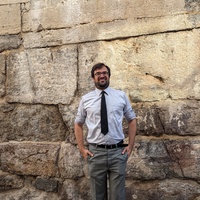MA Dissertation by Reuven Chaim Klein
ביאורים ארוכים ומקיפים שכתבתי בימי חורפי והוא כולו כלול מדברי עיון והלכה בעניינים שונים, משולבים ... more ביאורים ארוכים ומקיפים שכתבתי בימי חורפי והוא כולו כלול מדברי עיון והלכה בעניינים שונים, משולבים בהבנות מחודשות ודיונים מעמיקים ביסודות התורה והמצוות, אשר נמסרו מרבותינו הקדושים והחכמים מדורי דורות. מוגש בזה לכל דורש ומבקש דעת אמת בעיון ובלימוד מתוך יראת שמים, למען ירחיב הלומד את ידיעותיו ויבין בעמקי התורה.

The Law Teacher, 2024
This qualitative study explores the potential ways that a traditional Yeshiva education (TYE) hel... more This qualitative study explores the potential ways that a traditional Yeshiva education (TYE) helps prepare students for entering and succeeding in law school. The researcher interviewed five rabbi-law professors for their take on this phenomenon and compared the results of those findings with the scholarly literature on the topic to date. Much of that existing scholarly literature focuses on how a Yeshiva education might help students who later switch to law school because of the Yeshiva’s focus on Talmud study, as well as the Yeshiva’s use of the Socratic Method and dyadic Chavrusa study models. To that end, this study sheds light on the various aspects of traditional Yeshiva education that could be beneficial for those pursuing a legal career. The findings demonstrate that there is a broad consensus that Yeshiva education fosters critical thinking and analytical skills through its emphasis on Talmud study, which can be advantageous in comprehending complex legal concepts and arguments. Moreover, exposure to aspects of the law school culture and methodology during Yeshiva education can arguably prepare students for its use by law teachers in law school, contributing to their ability to productively engage in thoughtful and probing discussions.
This report presents findings in three key areas: 1. Data from the field regarding Hebrew in Jewi... more This report presents findings in three key areas: 1. Data from the field regarding Hebrew in Jewish day schools, teachers of Hebrew language, and the development and availability of normative student assessments; 2. Hebrew initiatives in curriculum, resources, social media, Hebrew teacher placement, "Leading in Hebrew" demonstration schools, camps, and Hebrew educator competencies; and 3. COVID-19 current challenges and trends, specifically and most importantly, the "COVID keeps" that have changed the face of teaching for the better.

The dual curriculum model ubiquitous to Orthodox Jewish day schools in North America typically bi... more The dual curriculum model ubiquitous to Orthodox Jewish day schools in North America typically bifurcates into religious (Judaic) studies and general studies. While most classes generally fit into one of those two halves of the curriculum, some classes are not intuitively categorized as wholly belonging to one part over the other. One of those classes is Ivrit (Modern Hebrew). This study aims to describe Ivrit’s place in the dual curriculum model and the various factors that contribute to that reality by exploring the context in which Ivrit emerged as a subject-matter for Orthodox schools and seeking to identify trends in the ways Ivrit is taught. This paper lays out the theories behind how ideology influences curriculum formation and documents how Hebrew has fit into the curriculum of Jewish Education throughout the ages. It also provides a picture of the particular context of North American Orthodox Jewry that this study focuses on, as well as a review of the different theories behind Hebrew education (heritage language vs. communicative language). With this theoretical background in hand, this dissertation surveyed 36 Orthodox high schools in North America to better understand how they viewed Ivrit’s place and shows that ultimately this subject’s place in the dual curriculum model remains ambiguous. Documenting how Ivrit is taught and examining the reasons as to why Ivrit is taught helped shed light on Ivrit’s precarious place in the dual curriculum model, as some of those policies/techniques/motives seem to line up with the aims of the Judaic studies curriculum, while others seemingly reflect the goals of the general studies curriculum.
JBQ Articles by Reuven Chaim Klein

Jewish Bible Quarterly, Jan 1, 2024
This paper outlines an investigation into three instances within the Babylonian Talmud where bibl... more This paper outlines an investigation into three instances within the Babylonian Talmud where biblical stories of sexual encounters are interpreted as multi-coital events involving figures like King David, Bathsheba, Zimri, Cozbi, Sisera, and Jael. Despite the absence of explicit descriptions of sexual encounters in the Bible, the Talmud confidently asserts the occurrence of multiple acts of coitus in each case, without explaining how this interpretation contributes to understanding the narratives. The study aims to elucidate a common theme across these episodes, positing that the motif of "sex as power" underpins the Talmud's unconventional assertions. It argues that male biblical characters utilized their supposed multi-coital abilities as a means of showcasing dominance and power over others, circumventing physiological constraints to assert control. The concept of "sex as power" frames sexual activity as a tool for asserting dominance, control, or influence, with individuals leveraging their sexual prowess to achieve specific objectives. In these instances, women serve as passive recipients, while men use sexual performance as a strategic display of status and dominance. By contextualizing these episodes within their broader biblical and rabbinic discourse, the study examines the background of each narrative, introduces Talmudic interpretations of multiple coital acts, and explores their alignment with the motif of "sex as power." It concludes by addressing the inflated nature of the Talmud's assertions within the literary convention of "stock" numbers, providing insight into the interpretive lens through which these stories are understood.
Jewish Bible Quarterly, Apr 2017
This article discusses various rabbinic approaches to the story of Elisha and Gehazi (recorded in... more This article discusses various rabbinic approaches to the story of Elisha and Gehazi (recorded in the Book of Kings), in which the former sends the latter with his staff to resurrect the Shunammite woman's dead child. Gehazi proves unsuccessful in that endeavor and Elisha himself ultimates revives the dead child.
Jewish Bible Quarterly, Oct 2018
This article discusses the identity of the Daniel character mentioned in the Book of Ezekiel.
Jewish Bible Quarterly, Jul 2018
A discussion of the different lists of Canaanite nations in the Bible.
Jewish Bible Quarterly, Apr 2018
A discussion of the different lists of Canaanite nations in the Bible.
Jewish Bible Quarterly, 2018
This article discusses the reason behind Jeroboam, king of Israel, instituting a holiday in the e... more This article discusses the reason behind Jeroboam, king of Israel, instituting a holiday in the eighth month of calendar. We suggest an approach that looks at this holiday as misplaced from the seventh month by means of an additional unauthorized leap-month.
Jewish Bible Quarterly, Apr 2017
This article discusses various rabbinic approaches to the story of Elisha and Gehazi (recorded in... more This article discusses various rabbinic approaches to the story of Elisha and Gehazi (recorded in the Book of Kings), in which the former sends the latter with his staff to resurrect the Shunammite woman's dead child. Gehazi proves unsuccessful in that endeavor and Elisha himself ultimates revives the dead child.
Jewish Bible Quarterly, Oct 2016
Jewish Bible Quarterly, Oct 2015
This articles notes the apparent discrepancies between Ezekiel 45-46 and Numbers 28-29 concerning... more This articles notes the apparent discrepancies between Ezekiel 45-46 and Numbers 28-29 concerning the required sacrifices to be offered on special days of the Jewish Calendar. The article also offers classical rabbinic solutions to those contradictions.
This article discusses various Rabbinic positions regarding whether Ezra the Scribe—who was a Koh... more This article discusses various Rabbinic positions regarding whether Ezra the Scribe—who was a Kohen—served as the High Priest in the Holy Temple after returning to Jerusalem from the Babylonian Exile. In doing so, the article explains the relationship between Ezra and Joshua ben Jehozedek and traces the history of the returnees from Babylonian Exile. Several proofs from Mishnaic and Midrashic sources are considered and some are rejected. Special attention is given to the stance of Maimonides on this issue. In attempting to reconcile these sources, the article proposes a difference between the terms “High Priest” and “Chief Priest”.
Jewish Bible Quarterly, Jan 2014
This article addresses the discrepancies within Biblical sources concerning the parentage of Quee... more This article addresses the discrepancies within Biblical sources concerning the parentage of Queen Athaliah of Judah whether she is a daughter of Omri, king of Israel or Ahab, king of Israel. The article also discusses the three marriages recorded in Biblical and rabbinic texts between the royalty of the Kingdom of Judah and the Kingdom of Israel as well as answers questions regarding the apparent incestual nature of one of those marriages.
Jewish Bible Quarterly, Oct 2014
This paper discusses various Medieval approaches to reconciling the apparent contradiction in the... more This paper discusses various Medieval approaches to reconciling the apparent contradiction in the names of Esau's wives as given in the book of Genesis. It explores the merits and disadvantages of each approach and concludes with a succinct summary. This paper was printed in the Jewish Bible Quarterly, Oct. 2014 (Vol. 42, No. 4).
This paper traces various interpretations for the reason of the Biblical shunning of the nations ... more This paper traces various interpretations for the reason of the Biblical shunning of the nations Ammon and Moab. The Torah in the Book of Deuteronomy seems to condemn them for not offering the Israelites food and water in their desert sojourns, but more analysis reveals more.
Misc. English Articles by Reuven Chaim Klein
Religious Education, 2023
This paper focuses on two elements of the Passover Seder ritual and their connection to Piagetian... more This paper focuses on two elements of the Passover Seder ritual and their connection to Piagetian education theory. After outlining Piaget’s theory of genetic epistemology and its implications for education theory, it focuses on Sigel’s distancing theory, which touts question asking as a tool for presenting information to students. This paper argues that the Jewish ritual of the Passover Seder was formulated with such pedagogical methods in mind, especially as it concerns the role of questioning. This paper also discusses storytelling’s importance as an effective tool in pedagogical instruction, and how the Passover Seder also takes advantage of that modality to make the ritual more impactful for educational purposes.
Religious Education, 2023
This paper focuses on two elements of the Passover Seder ritual and their connection to Piagetian... more This paper focuses on two elements of the Passover Seder ritual and their connection to Piagetian education theory. After outlining Piaget’s theory of genetic epistemology and its implications for education theory, it focuses on Sigel’s distancing theory, which touts question asking as a tool for presenting information to students. This paper argues that the Jewish ritual of the Passover Seder was formulated with such pedagogical methods in mind, especially as it concerns the role of questioning. This paper also discusses storytelling’s importance as an effective tool in pedagogical instruction, and how the Passover Seder also takes advantage of that modality to make the ritual more impactful for educational purposes.











Uploads
MA Dissertation by Reuven Chaim Klein
JBQ Articles by Reuven Chaim Klein
Misc. English Articles by Reuven Chaim Klein
-By Rabbi Reuven Chaim (Rudolph) Klein
A more complete version of this paper was printed in Nov. 2014 under the name Lashon HaKodesh: History, Holiness, & Hebrew (Mosaica Press, 2014).
The speeches were delivered in Hebrew by the following people:
* Rabbi Reuven Horowitz
* Rabbi Reuven Chaim Klein
* Rabbi Sholom Tzvi Brown
* Rabbi Zelig Horowitz
* Mr. Larry Pfeffer
The speeches were delivered in Hebrew by the following people:
* Reuven Chaim Klein
* Reuven Meir Horowitz
* Rabbi Newman, Rosh Yeshiva of Har Nof"
Throughout Jewish literature, the Hebrew language is referred to as Lashon HaKodesh. Its history, origins, decline, and rebirth are simply fascinating. Furthermore, at its deepest level, Lashon HaKodesh is called such (“the Holy Language”) because it is intrinsically sacred – and is thus unlike any other language known to Man.
Lashon HaKodesh: History, Holiness, & Hebrew seeks to understand the holiness of Lashon HaKodesh, follows its history, and focuses on the significance of Aramaic and other ‘Jewish languages’ such as Yiddish and Ladino. An extended section is devoted to Modern Hebrew, its controversies, and its implications from a religious perspective. This unique work delves into the linguistic history of each ‘Jewish language’, as well as the philological, Kabbalistic, and Halachic approaches to this topic taken by various Rabbinic figures through the ages. The author also compares and contrasts traditional Jewish views to those of modern-day academia, offering proofs and difficulties to both approaches.
As the old saying goes, “Two Jews, three opinions.” In almost every chapter, more than one way of looking at the matter at hand is presented. In some cases, the differing opinions can be harmonized, but ultimately many matters remain subject to dispute. Hopefully, the mere knowledge of these sources will whet the reader’s intellectual curiosity to learn more.
Written by a brilliant young scholar, Lashon HaKodesh: History, Holiness, & Hebrew is ground-breaking, intriguing, and remarkable.
1. The Kingship of Moses and Joshua- This paper explores the halachik status of whether or not Moses and Joshua were considered kings.
2. Holiday for Trees- This paper discusses varying opines in explaining the holiday of Tu B'Shvat according to Jewish philosophy
3. Building the Third Holy Temple- This paper elaborates on a dispute between Rashi and Maimonides about whether the Third Holy Temple will be manmade or not
4. Prophesies of the Oracle- This paper examines whether the Urim and Tummim were present during the Second Holy Temple periodץ"
Chapter 1: Beowulf: A View of Civilization ............... 1:5
Chapter 2: A Timeless Classic: Canturbury Tales ....... 2:6
Chapter 3: Macbeth ................ 3:8
Chapter 4: Machiavelli: A view of leadership ........... 4:10
Footnotes to Machiavelli: A View of Leadership ...... 4:12
Chapter 5: The New Land .............. 5:12
Chapter 6: A Point of Agreement ...... 6:13
Chapter 7: Puritanism in Literature.............. 7:14
Chapter 8: Nathaniel Hawthorne: Trust in Others ..... 8:17
Chapter 9: A Melting Pot or Salad Bowl? ....... 9:18
Chapter 10: A biographical sketch of Edgar Allan Poe ....... 10:19
Chapter 11: New Romanticism ........ 11:20
Chapter 12: Two Views of Death .............. 12:22
Chapter 13: Stephen Crane: An analysis ....... 13:23
Chapter 14: Leggatt: An Unusual Secret ....... 14:27
Chapter 15: A biographical sketch of Abraham Stoker ...... 15:27
Chapter 16: Allan Sillitoe: A View of an Individual ............. 16:28
Chapter 17: Barbara Tuchman: Revolutions ............ 17:32
Unit II -- Fiction:
Chapter 18: The Briefcase ........... 18:33
Chapter 19: The Chaser ............... 19:35
Chapter 20: IQ Day: The Story ........ 20:36
Chapter 21: The Haunted House ...... 21:37
Chapter 22: The Ditcher............... 22:39
Chapter 23: The Problem ............. 23:40
Chapter 24: The Empty Room ......... 24:41
Chapter 25: The Greatest Singer in the World......... 25:41
Chapter 26: Graduation ...... 26:42
Chapter 27: Risk ................ 27:43
Chapter 28: Boy King Get Coroneted ........ 28:44
Chapter 29: Releasing It............... 29:44